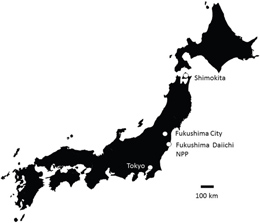Research Abstract
福島第一原子力発電所の災害による野生ニホンザルの血球数減少
Low blood cell counts in wild Japanese monkeys after the Fukushima Daiichi nuclear disaster
2014年7月24日 Scientific Reports 4 : 5793 doi: 10.1038/srep05793

2012年4月、我々は、福島市の森林地域に生息する野生ニホンザル個体群を対象として、1年間の血液学的検査を実施した。この地域は、2011年の東日本大震災で環境中に大量の放射性物質を放出した福島第一原子力発電所から70 kmの位置にある。比較のため、同原発から約400 km離れた青森県の下北半島に生息するサルの検査も行った。福島のサルの筋肉中総セシウム濃度は78~1778 Bq/kgの範囲であったが、下北半島のサルのセシウム濃度は全て検出限界未満であった。下北半島のサルと比較して福島のサルは、白血球数、赤血球数、ヘモグロビン、およびヘマトクリットが有意に低く、幼獣の白血球数には筋肉中総セシウム濃度との間に有意な負の相関が認められた。今回の結果は、何らかの放射性物質による被曝が福島のサルの血液学的変化に寄与したことを示唆している。
落合 和彦1, 羽山 伸一1, 名切 幸枝1, 中西 せつ子2, 石井 奈穂美1, 宇野 大基1, 加藤 卓也1, 今野 文治3, 川本 芳4, 土田 修一1 & 近江 俊徳1
- 日本獣医生命科学大学
- NPO法人 どうぶつたちの病院
- 新ふくしま農業協同組合
- 京都大学 霊長類研究所
In April 2012 we carried out a 1-year hematological study on a population of wild Japanese monkeys inhabiting the forest area of Fukushima City. This area is located 70 km from the Fukushima Daiichi Nuclear Power Plant (NPP), which released a large amount of radioactive material into the environment following the Great East Japan Earthquake of 2011. For comparison, we examined monkeys inhabiting the Shimokita Peninsula in Aomori Prefecture, located approximately 400 km from the NPP. Total muscle cesium concentration in Fukushima monkeys was in the range of 78–1778 Bq/kg, whereas the level of cesium was below the detection limit in all Shimokita monkeys. Compared with Shimokita monkeys, Fukushima monkeys had significantly low white and red blood cell counts, hemoglobin, and hematocrit, and the white blood cell count in immature monkeys showed a significant negative correlation with muscle cesium concentration. These results suggest that the exposure to some form of radioactive material contributed to hematological changes in Fukushima monkeys.

